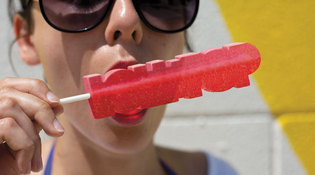 loading
loading
Arts & CultureYou can quote them: New Haven firstsPizza? Nah. Frisbees? Maybe. Lollipops? All signs point to yes. Yale law librarian Fred R. Shapiro is editor of the Yale Book of Quotations.  John Paul ChirdonView full imageThe list of “firsts” claimed for New Haven is astoundingly long. Wikipedia lists, to name only a few, the first cotton gin, telephone exchange, and chemotherapy. The website Visit New Haven adds the first fire sprinkler, artificial ice machine, public tree planting system, and many more. In this column I will look into just three of the claims—examining recorded uses of words, which are not definitive but provide important evidence. That evidence is not all on New Haven’s side. One widely credited Yale–New Haven first is the Frisbee, as Judith Ann Schiff, Yale’s chief research archivist, has discussed (“The Frisbee Files,” May/June 2007). She cited accounts by Sam Carr Polk ’47JD that he brought a pie-tin tossing game to Yale in 1946, and by Stephen I. Zetterberg ’42LLB that he played such a game—called “Frisbie” because the tins were from the Frisbie Pie Company of Bridgeport, Connecticut—at Yale Law School in 1939. (Wham-O would trademark the name “Frisbee” in 1959.) These are valuable accounts, but they contradict each other, and both were given long after the fact. And a search of digitized college newspapers for variants of “frisbie” fails to provide the hard evidence for Yale’s primacy that we would hope for. The earliest use in the Yale Daily News was a 1957 ad offering “Space-saucers (frisbies to many) designed for easy fun.” There were slightly earlier occurrences in the Daily Princetonian (1956), Middlebury Campus (1956), The Dartmouth (1954), and Western Maryland College’s Gold Bug (1954). Evidently the rivalry was already on: the Gold Bug declared, “For the information of Johns Hopkins, Harvard, Yale, Princeton, and other ancient schools, we are the first and only college in the US to play this game.” Can the Gold Bug’s claim be overturned? I invite readers to send me their evidence, documented or anecdotal, for Yalie frisbee-ing before 1955. Primacy in this all-important matter needs to be restored. Another prominent first often claimed for New Haven is American pizza. The Yale College admissions website, for example, describes the celebrated Frank Pepe Pizzeria Napoletana as “home to the first pizza in America.” The restaurant opened in 1925, but the earliest year when Pepe might have made his pizzas in New Haven was 1909, when, according to the restaurant’s website, he arrived in the United States. That date shows that the first American pizza was baked elsewhere. The word historian Barry Popik has found an article in a 1903 Boston Journal about shops that sold the pies and had “the words ‘Pizze Cavule’ on the windows.” As for Pepe’s, it is recognized as the originator of the “New Haven–style” thin-crust pizza and the white clam pie, but does not itself claim more than that. Finally, the lollipop. According to the Visit New Haven website, the notion of a candy with a handle was born when “George C. Smith of Bradley-Smith Candy Company, New Haven, decided in 1892 to put sticks into balls of candy he was making.” Did Smith create the first lollipop? The Oxford English Dictionary seems to deny his claim, because it documents “lollipop” as early as 1784. But the OED also gives a dialectal definition of the word as, simply, “a sweetmeat… that dissolves easily in the mouth.” Moreover, none of the OED’s pre-1892 citations are clearly about sweets on sticks. From 1796, for instance, we have the note that lollipops are “sweet lozenges purchased by children.” And since I have searched newspaper databases in the UK and US for mentions of lollies on sticks before 1892, and have found none, let’s call this one a plausible “yes” for the Elm City. Take that, Boston and Western Maryland College.
The comment period has expired.
|
|